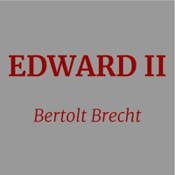
In 1924, Bertolt Brecht’s experimentations with Epic Theatre began with his production of Edward II. Inspired by Christopher Marlowe’s Renaissance play of the same name, Brecht (along with his collaborator Lion Feuchtwanger) stated that he “wanted to make possible a production which would break with the Shakespearean tradition common to German theatres: that lumpy monumental style beloved of middle-class philistines.” In Brecht’s version of Edward II, the titular king rejects the advice of his barons and indulges in a relationship with Piers Gaveston. While King Edward sates his personal desires, Anne (the queen) finds herself seduced by Lord Mortimer as England tumbles toward civil war. When King Edward is captured, he refuses to abdicate the throne, and (accurate to history) is moved throughout England as a prisoner of war until his young son takes control. Sometimes poetic, sometimes vulgar, but always aware of political influences, Brecht’s Edward II is a dynamic examination of the consequences when a monarch chooses his own desires over the interests of his country.
Edward II guide sections